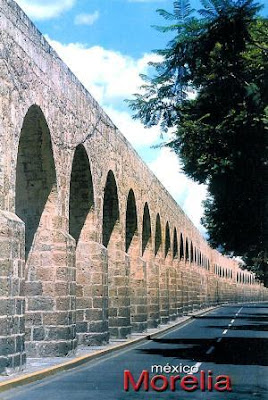Last July I joined this great RR. The idea is to send cards (1 card minimum, 8 cards maximum) according to the receivers favorites or wishlists. I've already joined 3 times and I always send 4 cards, in return I get the same number of cards but I don't know who'll send them. So far, i've only got nice cards. These are the 1st four I got, from Germany, Netherlands, France and Ireland.
I've already sent a couple of cards to Antje, tags, but this was the 1st card I got from her. This is the Old Bridge in Jena, built in 1534. It was destroyed during the Thirty Years War (1637), reconstructed in 1706 and received its present appearance in 1744 . During World War II on April 12, 1945, a few arches were damaged. The reconstruction started in 2001 and was completed in 2004.
© The online postcard shop
Marina sent me this beautiful card of the Heeswijk Castle, located near Heeswijk in the North Brabant province of the Netherlands. The castle was originally constructed during the 11th century and was later restored in 2005. A motte was first erected in 1080, but would be reduced over the next few centuries. A castle would eventually be built in its place.
Heeswijk Castle was an integral part of the history of the Netherlands. Prince Mauritis failed twice to take over Heeswijk in 1600. His half-brother Frederick Henry, however, did succeed in 1629. This allowed him to attack ‘s-Hertogenbosch.
In 1649, the castle was transformed into a baroque residence and lost its defensive features. In 1672, Louis XIV stayed at Heeswijk while campaigning against the Dutch Republic. King Charles II of England as well as the bishops of Munster and Cologne visited the castle to sign the Treaty of Heeswijk.
General Pichegru, who was under Napolean’s command, used the castle as a headquarters in the late 18th century. In the early 1800s, the castle was purchased by Andre Baron van den Bogaerde van Terbrugge. However, by this time, the castle had already fallen into a state of disrepair. Reconstruction began and the castle was then expanded to include an armory. The “Iron Tower” was also constructed and served as a place to store his son’s collection of art and curiosa.
Surprisingly, the castle only suffered minimal damage during World War II. In 1944, the parachutists of the 101st Airborne Division actually landed around Heeswijk Castle. - in: http://www.netherlands-tourism.com/heeswijk-castle/
Photo: Marc-Olivier Sicard
Another castle, this one from France, sent by Nathalie.
Unusually among the historical castles of France, Rambouillet plays a role as important now as it did in the past - it is now the summer residence for French presidents, and frequent host to heads of state from other countries.
Dating from the 14th century, at which time it was a manor house, it gained importance as an occasional royal residence, and it was here that King Francois I died in 1547.
The castle retains a medieval defensive form, with turrets in each corner of the building, although the castle has been very extensively altered during the follwoing centuries.
The extensive gardens and parkland that surround the castle were laid out during the first half of the 17th century - the castle is surrounded by 200 square kilometres of land, much of it covered by ancient forests. The garden is significantly more 'English' in style than many of the castles in the Paris region and the Loire Valley.
Towards the end of the 18th century the castle passed to the crown under Louis XVI, bought as a gift for Marie Antoinette. It's political importance continued into the 19th century - Napoleon occasionally stayed here, and his 'successor' King Charles X, abdicated at the castle.
It is from the end of the 19th century that Rambouillet has acted as the official French Presidential summer residence.
During the 20th century many important meetings and summits have been held here. General de Gaulle frequently held important receptions at the castle. More recent engagements have included the G6 meetings of leading industrialised nations, Kosovo peace agreement discussions, and state visits by Boris Yeltsin and Nelson Mandela. - in: http://www.castles.francethisway.com/chateau-rambouillet.php
Photography reproduced from original artistic work © Liam Blake
And the last card of the July's RR came from Ireland, sent by John. In a few weeks, 4, I'll visit Trinity College in Dublin.
Trinity College, known in full as the College of the Holy and Undivided Trinity of Queen Elizabeth near Dublin, is a research university and the sole constituent college of the University of Dublin in Ireland. The college was founded in 1592 as the "mother" of a new university,[Note 1] modelled after the collegiate universities of Oxford and of Cambridge, but, unlike these, only one college was ever established; as such, the designations "Trinity College" and "University of Dublin" are usually synonymous for practical purposes. It is one of the seven ancient universities of Britain and Ireland, as well as Ireland's oldest university. - in: wikipedia







































